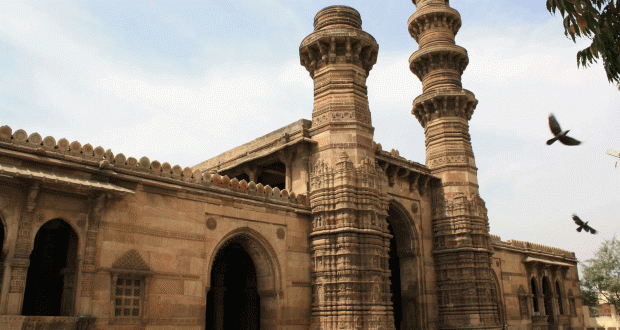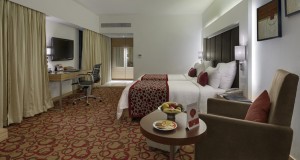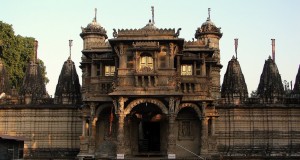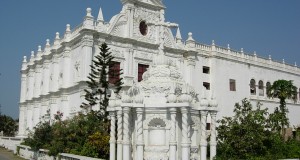The Tourism Corporation of Gujarat has several conducted tours for local sightseeing in Ahmadabad, as well as excursions to nearby places of interest like Gandhinagar, Modhera, Lothal and a host of other destinations. The Ahmadabad Municipal Transport Service (tel 365610) also runs conducted tours for local sightseeing. As their timings are constantly being changed, get up-to-date details from the Gujarat Tourism office in H.K. House off Ashram Road.
City Sights Round-up (on foot and by car; 4-5 hours)
Jumma Masjid-Teen Darwaza-Bhadra Fort-Sidi Saiyad Mosque-
Rani Rupmati Masjid-Hathee Singh Jain Temple-Shaking Minarets-
Dada Harini Dev Baoli-Matar Bhavani Baoli-Kankaria Lake-
Calico Textile Museum-Utensils Museum-Sarkhez Roza-M.K. Gandhi Ashram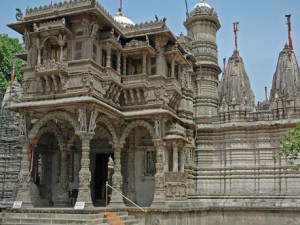
Jumma Masjid situated almost at the center of the walled city is a good place to start. This mosque, built in 1423 by Sultan Ahmed Shah in the Indo-Saracenic architectural style, is outstanding for its grand scale, superb proportions and exquisite workmanship. Fifteen domes of varying elevations are supported by over 300 pillars, and one of the achievements of the design is the successful filtering of light so no direct sunlight falls into the building. The ‘shaking minarets’ of this mosque were destroyed in an earthquake in 1818. (Similar minarets survive in the Siddi Bashir Mosque, see below.) Immediately to the west of the mosque is Teen Darwaza, a triple-arched gate, erected by Sultan Ahmed Shah to serve as the royal entrance to the Royal Square (Maidan Shah) of his eponymous city. Further west of Jumma Masjid is the ancient citadel now known as Bhadra Fort.
The foundations of this fort were laid in AD 1411 but it takes its name from the temple to Goddess Bhadrakali, built by the Marathas within the fort when this came under their control in the 18th century. Beside the post office and court, which occupy an old palace next to the fort, is the Sidi Saiyad Mosque completed in AD 1472 by a slave. 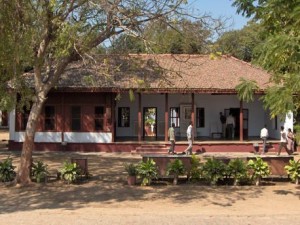 The mosque contains famous filigree stone windows; note particularly those on the west wall. A little to the north is the Rani Rupmati Masjid—just south of the Grand Hotel and south-west of the Delhi Gate. Built between 1430-40, this mosque was named after Rani Rupmati the Hindu queen of Sultan Mehmud Shah Beghara. Richly ornamented with carvings and finely crafted marble screens, it presents a fine example of the synthesis of Hindu and Muslim architecture. Hathee Singh Jain Temple just north of Delhi Gate was built in 1550 by a rich merchant. Of pure white marble and decorated with rich carvings, this temple rivals the beauty of the famous Jain temple of Mount Abu.
The mosque contains famous filigree stone windows; note particularly those on the west wall. A little to the north is the Rani Rupmati Masjid—just south of the Grand Hotel and south-west of the Delhi Gate. Built between 1430-40, this mosque was named after Rani Rupmati the Hindu queen of Sultan Mehmud Shah Beghara. Richly ornamented with carvings and finely crafted marble screens, it presents a fine example of the synthesis of Hindu and Muslim architecture. Hathee Singh Jain Temple just north of Delhi Gate was built in 1550 by a rich merchant. Of pure white marble and decorated with rich carvings, this temple rivals the beauty of the famous Jain temple of Mount Abu.
The Shaking Minarets which are part of the Siddi Bashir Mosque, 2.5 km (1 1/2 miles) from the city centre, can be swayed by a little force applied to the top-most arch. When one minar is shaken, the vibrations are communicated to the other minar via a stone-bridge, and the second minar starts shaking. A similar pair of minarets existed in the Rajabai Mosque but were damaged in the 19th century.
A common architectural feature of Gujarat is the step-well or baoli. Many were built adjoining 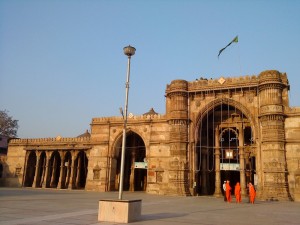 temples, and apart from being cool sources of water, they are often used as retreats in the hot, dry summer months. The Dada Harini step-well was built in AD 1501 by one of the ladies of Sultan Mehmud Shah Beghara’s court. This has a spiral staircase leading down to the central reservoir. The walls’ steps and supporting pillars are splendidly carved. A little to the north is the older Mata Bhavani Baoli and both are about 800 m north-east of the Daryapur Gate. Sultan Qutb-ud-din had the Kankaria Lake, to the south-east of the city, constructed in AD 1451. There is an island in the center containing a summer palace known as Nagina Wadi and it is possible to hire a boat for a few rupees to reach it.
temples, and apart from being cool sources of water, they are often used as retreats in the hot, dry summer months. The Dada Harini step-well was built in AD 1501 by one of the ladies of Sultan Mehmud Shah Beghara’s court. This has a spiral staircase leading down to the central reservoir. The walls’ steps and supporting pillars are splendidly carved. A little to the north is the older Mata Bhavani Baoli and both are about 800 m north-east of the Daryapur Gate. Sultan Qutb-ud-din had the Kankaria Lake, to the south-east of the city, constructed in AD 1451. There is an island in the center containing a summer palace known as Nagina Wadi and it is possible to hire a boat for a few rupees to reach it.
Ahmadabad has two excellent and unusual museums. The Calico Textile Museum in the Shanti Bagh Area, is only appropriate in a city which owes much of its prosperity to textiles. One of the finest such museums in the world, it was founded in 1949 and is open 10 am-12.30 pm and 2.30-5 pm every day except Wednesday. The other unusual museum is the Utensils Museum at the Vechaar Vishalla Environmental Centre on the Sarkhej Road 5 km (3 1/4 miles) from the city center. The museum has an extraordinary range of items in daily use over the last couple of centuries throughout the country. Nearby is the vegetarian restaurant from which the museum grew (see below).
One of the architectural marvels of Ahmadabad is the Sarkhez Roza at Sarkhej about 8 km (5 miles) 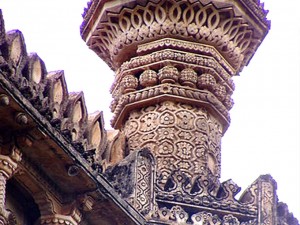 south-west of the city. This group of structures built around a large tank comprise the large tomb of Saint Ahmed Khattu Ganj Baksh the spiritual guide advisor to Sultan Ahmed Shah (built in 1445); an enormous but simply designed mosque constructed in 1454; and the tombs of Sultan Mehmud Shah Beghara and his queen Rajabai, built in 1460. Many years later the Dutch East India Company founded an indigo factory here.
south-west of the city. This group of structures built around a large tank comprise the large tomb of Saint Ahmed Khattu Ganj Baksh the spiritual guide advisor to Sultan Ahmed Shah (built in 1445); an enormous but simply designed mosque constructed in 1454; and the tombs of Sultan Mehmud Shah Beghara and his queen Rajabai, built in 1460. Many years later the Dutch East India Company founded an indigo factory here.
About 6 km (4 miles) from the city, on the banks of the Sabarmati river, is the Ashram founded by Mohandas Karamchand Gandhi in 1917, on his return from South Africa. This quiet retreat was to grow into the nerve centre of the Indian freedom movement and was the starting point of Gandhi’s 385-km (240-mile) march to Dandi in 1930, when 90 000 people demonstrated against the government Salt Tax.
EXCURSIONS
At a short distance away from Ahmedabad are several interesting sights. Among those are the Adalaj Vav (17 km; 11 miles), a fine example of the traditional step-well; and Lothal (80 km; 50 miles), where remains of Harappan Civilisation have been excavated recently. At Modhera (106 km; 60 miles) on the road north to Abu and Udaipur, are the remains of a fine Sun Temple built in AD 1026 by King Bhimdev I of the Solanki dynasty. Nal Sarovar (71 km; 44 miles) is a bird sanctuary which acts as the winter host to various species of migrant birds: rosy pelicans, Brahminy duck, flamingoes. Patan (130 km: 81 miles) is home to the families who weave the famous Patola silk saris which can be bought in Ahmadabad from Gurjari.
SHOPPING
Ahmedabad is famous for its textiles, gold jewellery and handicrafts. Various textile designs, as well as processes such as tie-and-dye, mirror-work and block-printing, are done locally and the products are of an excellent standard. Shops are located in the Teen Darwaza area. Gurjari, the Gujarat Handicrafts Emporium on Ashram Road and Gramodyog Gandhi Hat at Bhadra and Sabarmati Ashram are recommended for handicrafts.

